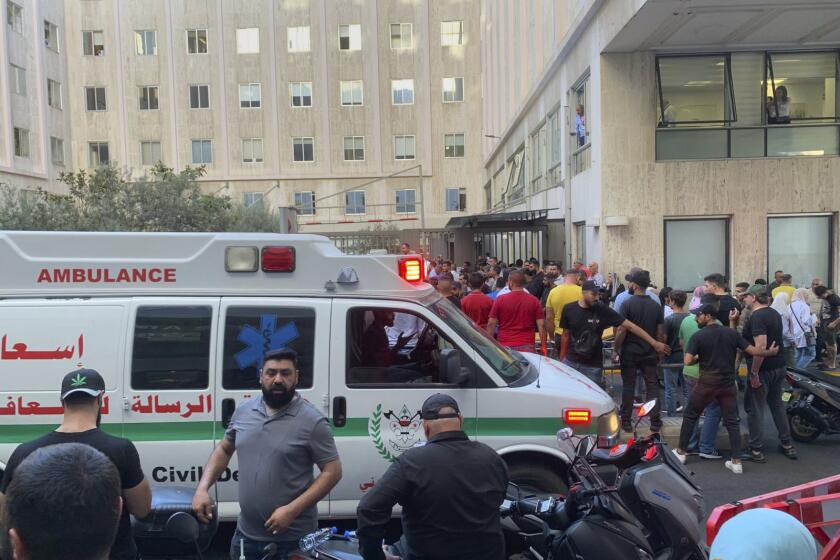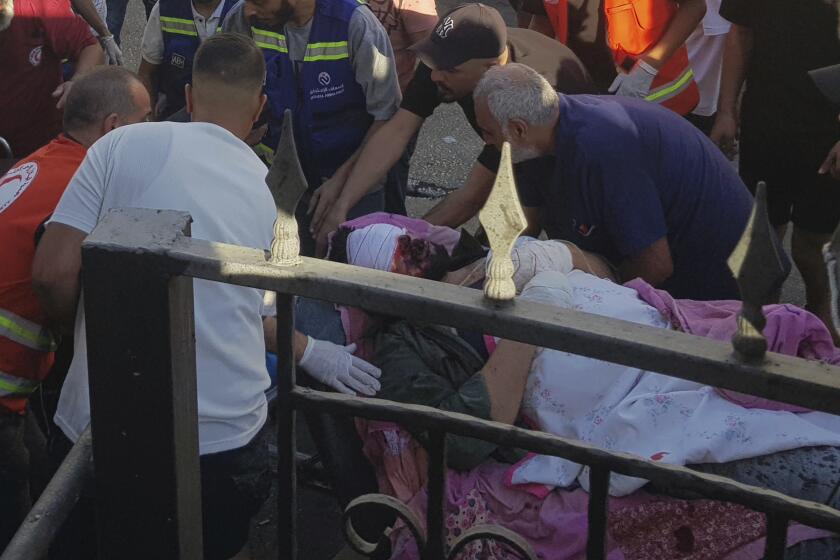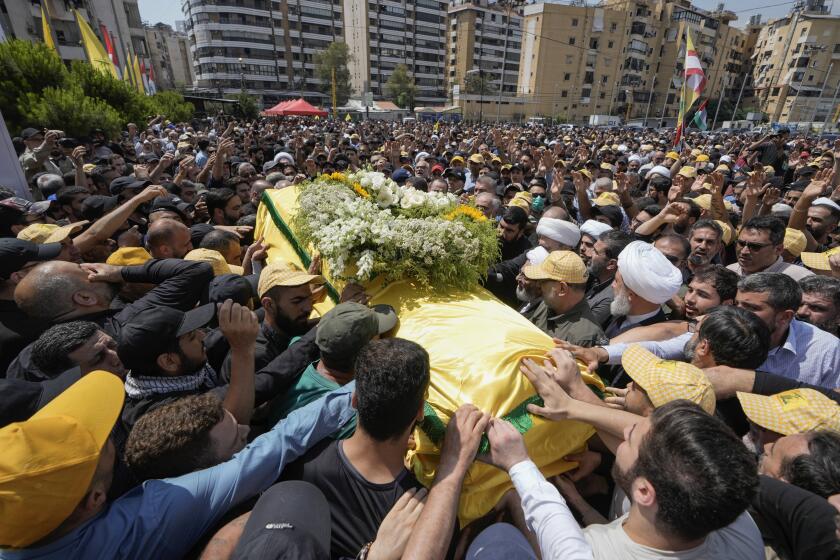Second wave of device explosions rocks Lebanon; 14 dead

- Share via
BEIRUT — A fresh wave of explosions caused by booby-trapped communication devices wracked Lebanon on Wednesday, the second such attack in as many days in what was believed to be an electronic sabotage campaign targeting Hezbollah.
The latest attack, which affected hundreds of walkie-talkies across the country, killed at least 14 people and wounded 450 others, the Lebanese health ministry said.
It comes on the heels of Tuesday’s bombings, which saw thousands of handheld pagers detonate, killing 12 people — including eight Hezbollah fighters, the group said, along with two children and a health worker — and leaving thousands of others with bloodied and mutilated hands, eyes and torsos.
Lebanon’s civil defense said its personnel were putting out fires inside “homes, cars and stores” in the Bekaa Valley in Lebanon’s south as well as in the capital’s southern suburbs — areas considered to be supportive of Hezbollah.
The Red Cross said it had deployed roughly 30 ambulance teams.
Gold Apollo, a wireless communications device manufacturer in Taiwan, said it did not make the pagers used in the Lebanon explosion attack.
The attack took place at roughly 5 p.m. local time, while Hezbollah officials were taking part in a large funeral ceremony for four victims of Tuesday’s pager explosions, including the son of a prominent Hezbollah lawmaker and a young boy.
Video from a funeral ceremony in the country’s south depicted an explosion inside an ambulance, leading bystanders to run away in panic. The Times could not independently verify the video.
The Lebanese state-run National News Agency said the devices targeted were ICOM IC-82 handheld VHF transceivers. They are not usually used by fighters, but by ambulance and civil defense crews and administrators affiliated with Hezbollah. The devices are unrestricted and can be sold to anyone, and as such are used by other organizations in areas of poor signal.
“No human being can express the savagery of this crime,” said Lebanon’s acting prime minister Najib Mikati in a televised press conference from the health ministry headquarters. “These are defenseless people, sitting in their homes, with death coming to them in this way.”
He added that he had asked for the U.N. Security Council to convene to discuss developments.
Battery experts weigh in on how the exploding pager attack in Lebanon could have been designed.
It was unclear how the devices were booby-trapped. Tuesday’s attack was believed to have involved interception and tampering with a shipment of some 5,000 pagers set to go for Hezbollah, and planted with a small amount of explosives. Observers said the walkie-talkies may have been ordered around the same time, but a report from the National News Agency said a three-year-old device had also blown up.
Though not as widespread as Tuesday’s round of sabotage, the walkie-talkies appeared to pack more explosive power. In Beirut’s Haret Hreik neighborhood, Hashem Safieddine, head of Hezbollah’s Executive Council, was giving an address when the thud of an explosion sounded nearby. The crowd convulsed in panic, with a voice on a loudspeaker telling people to remove batteries from their phones, according to live footage of the event.
The blast, which hit an apartment a few blocks away, started a fire, shrouding the entire block with thick white smoke. Rescue crews equipped with tanks and gas masks worked to rescue residents inside, with three fire trucks and four ambulances shimmying their way through narrow streets crowded with onlookers.
“We were choking. I couldn’t see anything,” said one elderly woman, walking out of the chaos towards relatives on a nearby street. Others joined her, a stream of men and women in soot-covered clothes and bloodshot eyes. A few hours later, crews emerged with a man on a stretcher and loaded him into one of several ambulances waiting nearby.
Deadly sabotage of pagers used by militant group Hezbollah is widely blamed on Israel — but what was attack’s real aim?
News of the second round of sabotage compounded panic across the country, with many fearing additional bouts of electronics tampering.
Wednesday’s attack is the latest salvo in a long-running conflict that has seen Israel land a series of palpable hits against Hezbollah, the Iran-backed paramilitary faction and one of the country’s most powerful political parties. In the last few months, Israel has successfully assassinated the group’s chief of staff, two regional division commanders, and dozens of officers in its special forces corps. Despite adopting heightened security measures, including substituting pagers for smartphones and proscribing internet-linked security cameras, Hezbollah operatives have struggled to evade Israeli surveillance.
Hezbollah began a rocket campaign in solidarity with Gaza one day after Hamas’ surprise assault on Oct. 7 — which killed some 1,200 Israelis. Israel responded with an attack against Gaza that to date has killed more than 41,000 Palestinians, Gaza health officials say.
The fighting between Hezbollah and Israel has displaced some 90,000 people in Lebanon and 60,000 in Israel.
After the second round of explosions in Lebanon, Prime Minister Benjamin Netanyahu released a cryptic video message in which he did not refer to the blasts, but promised to make the country’s northern border region safe for Israelis displaced by Hezbollah attacks.
That was widely interpreted as signaling a potential military escalation against the group.
“I’ve already said we will return residents of the north safely to their homes,” the prime minister said. “And that is exactly what we will do.”
Times staff writer Laura King contributed to this report from Tel Aviv.
More to Read
Sign up for Essential California
The most important California stories and recommendations in your inbox every morning.
You may occasionally receive promotional content from the Los Angeles Times.














